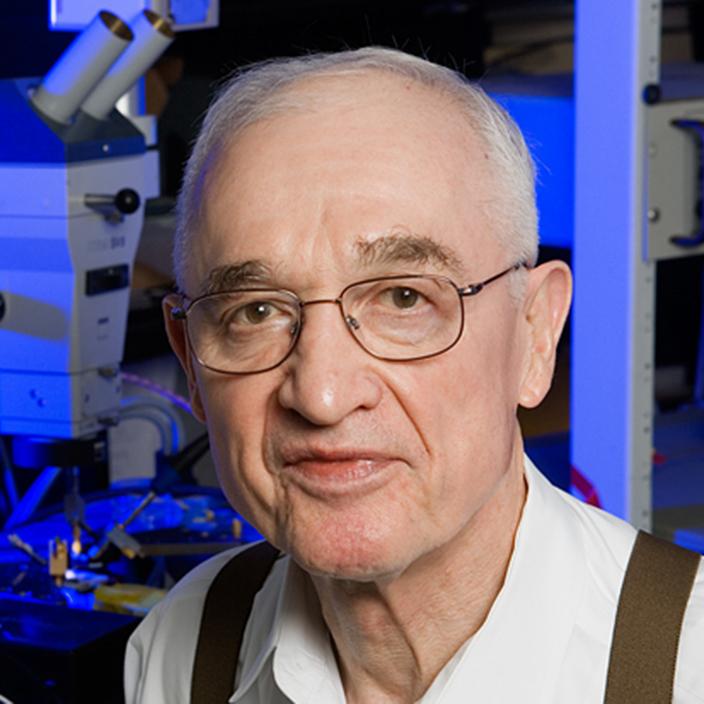
UNESCO declared 2015 to be the International Year of Light, noting how the light emitting diode (LED) alone had affected the quality of life of more than 1.5 billion people worldwide. Besides lighting, which consumes a quarter of the world’s energy, photonic devices such as lasers and LEDs provide the backbone of the Internet. Behind these inventions that have literally lit the world and produced the engine of the Information Age is the lifework of Nick Holonyak, Jr.
Holonyak was born in southern Illinois in 1928. His father was a coal miner who immigrated to the U.S. from the Carpathian Mountain region of Europe at the turn of the century. When Holonyak turned 14, he expected to follow his father into the mines for employment, but his parents had greater aspirations for him. After his father persuaded him to take any job above ground, Holonyak worked for the Illinois Central Railroad—a grueling job that affects his health to this day. When World War II ended, he took advantage of the GI Bill, which expanded universities to satellite campuses in order to accommodate returning soldiers. He enrolled in a college set up in a high school near his hometown, where he excelled at his studies in electronics. In 1947 he moved to the main campus of the University of Illinois at Urbana-Champaign to finish his undergraduate degree in 1950. He was the first graduate student of John Bardeen, a physicist and engineer with the unique distinction of having been honored with two Franklin Institute medals and two Nobel Prizes. Holonyak received his master's degree in 1951 and his doctoral in 1954, both in electrical engineering.
After earning his Ph.D., Holonyak worked at Bell Telephone Laboratories, where Bardeen’s celebrated work on transistors had been achieved. After a two-year period of service in the U.S. Army, he started work at General Electric Corporate Research Labs in Schenectady, New York, where he had a series of “firsts” in electronic and photonic devices. He developed a method to produce compounds of two or three elements into an almost perfect crystal, a pioneering feat that many of his colleagues thought impossible. With these techniques, he was able to develop devices that could emit light at wavelengths, or colors, that were not possible with a single element crystal such as silicon.
In 1962 Holonyak demonstrated the first visible (red) semiconductor laser and light-emitting diode, an invention that has been cited as one of the 45 most notable human achievements of the 20th century. For the first time in human history, visible light was generated without heating or burning material and as a result, the visible light industry was transformed. The technology provided a brighter, more reliable and far more energy-efficient—compared to incandescent light bulbs—means to light the world.
Holonyak joined academia in 1963, returning to the University of Illinois at the invitation of his Ph.D. advisor, where he continued his work on visible semiconductor lasers and light-emitting diodes. With his graduate students, he developed four-element compound semiconductors, in which different materials are sandwiched to produce small (quantum) wells. This technique enables new levels of performance in laser diodes. Today these quantum well lasers are found in a wide range of application areas, such as fiber-optic communications and the Internet, CDs, DVDs, medical diagnostic equipment, surgery, ophthalmology, printing, materials processing, instrumentation, spectroscopy, and many others.
Besides being a prolific inventor, Holonyak is a prominent educator as the John Bardeen Chair of Electrical Engineering at his alma mater, having supervised the doctoral degree programs of 60 graduate students, many of whom have gone on to become leaders in the field of electronics in their own right. At this time, five of his students are members of the National Academy of Engineering (NAE). Among many other awards, he was the recipient of the IEEE Edison Medal, the National Medal of Science, and the National Medal of Technology. In 2015 he shared with four others the NAE Charles Stark Draper Prize for his seminal contributions to LEDs.
With a lifetime of contributions to science and technology, the young boy that started work on the railroads of Illinois has now carved a path to light our future.
Information as of April 1, 2017

